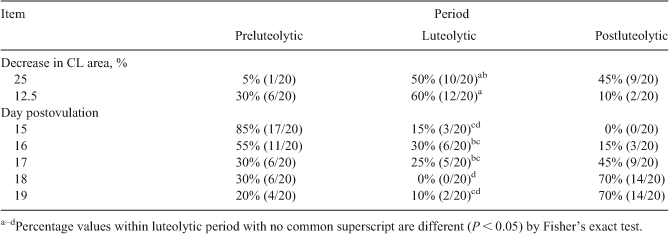173 USE OF CORPUS LUTEUM AREA AS A PREDICTOR OF ONGOING FUNCTIONAL LUTEOLYSIS IN DAIRY HEIFERS
G. Pugliesi A B , F. L. V. Pinaffi B C , M. A. Beg B and O. J. Ginther BA Department of Animal Reproduction, University of São Paulo, Pirassununga, SP, Brazil;
B Eutheria Foundation, Cross Plains, WI, USA;
C Department of Anatomy of Domestic Animals and Wildlife, University of São Paulo, Pirassununga, SP, Brazil
Reproduction, Fertility and Development 25(1) 235-235 https://doi.org/10.1071/RDv25n1Ab173
Published: 4 December 2012
Abstract
The beginning of functional luteolysis in cattle ranges from Days 16–19 (Day 0 = ovulation). During functional luteolysis, luteal size and blood flow decrease in heifers. The wide range of beginning of luteolysis and the low sensitivity of quick progesterone (P4) assays preclude targeting an individual for a specific period of luteolysis. The present study aimed to evaluate the changes in area and blood flow of corpus luteum (CL) during spontaneous luteolysis and test the hypothesis that a decrease in CL area (cm2) is more efficient in targeting the luteolytic period than using a specific day postovulation. Blood sampling and ultrasound scanning of CL were done every 12 h from Days 13–22 in dairy heifers (Holstein) and was used for a retrospective study (Experiment 1; n = 6 heifers). The P4 concentrations, maximum CL area, and the percentage of CL area with coloured signals of blood flow were centralized to 12-h sample when the end of luteolysis (P4 < 1 ng mL–1) was detected. The percentage decrease in CL area and blood flow between Day 13 and the 12-h sample before the end of luteolysis were calculated. In Experiment 2, a blood sampling and transrectal ultrasonography of CL were performed every 8 h starting on Day 14 to determine the beginning and end of functional luteolysis (n = 20 heifers). The hour of detection of luteolysis was defined as the scan at 8-h intervals when maximum CL area decreased by 25 or 12.5% on Day 14. Based on P4 concentrations, the preluteolytic, luteolytic, and postluteolytic periods in each heifer were identified. The area and blood flow were measured by a duplex B-mode and pulse-wave colour Doppler ultrasound instrument. In Experiment 1, the retrospective study indicated a 25% decrease in CL area and 65% decrease in blood flow 12 h before the end of functional luteolysis. In Experiment 2, the 25% and 12.5% CL area decrease from Day 14 occurred, respectively, on Days 18.1 ± 0.6 and 17.2 ± 0.5 postovulation. The hypothesis that a decrease in CL area is more efficient in targeting ongoing luteolysis than using a specific day postovulation was supported. This was indicated by the greater (P < 0.05) frequency of heifers detected in luteolytic period (12 of 20 heifers) using the criteria of a 12.5% decrease in CL area than using a specific day (Table 1). Using a day postovulation for obtaining heifers in the luteolytic phase was only 0 to 30% effective for targeting luteolysis. In conclusion, the technique of using an ultrasonic 12.5% reduction in CL area is a good tool to detect ongoing luteolysis and may be useful as an experimental design to study factors related to the luteolytic period in cattle.

|
Supported by grants from FAPESP (2012/04004-8 to GP).


